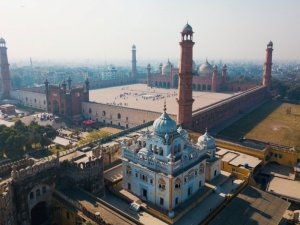The fresco art adorning some of the buildings left behind by Hindus, Sikhs and ascetic groups who migrated during partition is fascinating for its portrayal of Punjab’s women generations ago. This imagery documents historical attitudes towards women, and takes on even more importance when we realize how it contrasts with the forced erasure of women from art in Pakistan since the 1980s. Baba Bhumman Shah Udasi’s abandoned Durbar (shrine) in Dipalpur (District Okara) is a unique but relatively unknown heritage site that stands out not only for its depiction of women in fresco art but also because of what it can teach us about the evolution of religious identities in Punjab over the last century.
I came to learn about Bhumman Shah’s Durbar while reading Singapore based travel writer Amardeep Singh’s The Quest Continues: Lost Heritage - The Sikh Legacy in Pakistan. According to the Gazetteer of the Montgomery District (1883), Bhumman Shah was an Udasi Saint who lived between 1687 and 1756. The term Udasi refers to celibate ascetic orders who trace their common spiritual lineage to Baba Sri Chand, eldest of the two sons of Guru Nanak, the founder of Sikhism.
The Bhuman Shah Durbar complex comprises of an ornately decorated fort like structure that contains the Samadhis (shrines) of Baba Bhumman Shah Udasi , Baba Lalchand and Baba Darshan Dassji (Bhuman Shah’s fifth successor), residential quarters, and a large Durbar Hall that was used for ceremonies and congregational prayers. Before partition, a raised platform in the Darbar Hall featured a murti (statue) of Guru Nanak’s son Baba Sri Chand, alongside a painting of Bhumman Shah and the Sikh sacred scripture the Guru Granth Sahib. The Durbar’s residential quarters are currently occupied by Muslim families who migrated from East Punjab during partition.
The Udasis have a rich history of promoting interfaith harmony in Punjab. Before Sikh rule, about half a dozen of the old Udasi centers in Punjab received revenue free grants from Mughal rulers and the Afghan chiefs of Kasur. According to Udasi traditions, the village of Bhumman Shah was previously known as Kutab Kot. The village’s name was changed when Kutab Kot was gifted to Bhumman Shah by Lakha Wattoo, a powerful Musim landlord who was among the Udasi saint’s friends. During Sikh rule, about a hundred and fifty Udasi centers enjoyed state patronage across Punjab. The Udasi establishments functioned as centers of indigenous education in precolonial Punjab. Other than the sacred scriptures of Hinduism and Sikhism, pupils also received education in basic arithmetic, grammar and poetry. Bhumman Shah’s shrine also functioned as a vibrant cultural space for the people of Montgomery (now Sahiwal division). Colonial records indicate that twelve thousand people participated in fairs organized at Bhumman Shah’s shrine in the months of April and June 1883.
The fresco art in the shrine prominently features women in scenes from mythology, folklore, history and everyday life. Interpreting the art scenes requires an awareness of their underlying historical and social contexts, including Udasi beliefs. However, everyday visitors can still appreciate the depiction of women in complex roles: as lovers, knowledge seekers, devotees, entertainers, workers, hunters, celestial beings and victims of conflict. Though I couldn’t find any information that could point me towards the shrine’s construction date, a colourful fresco of a musket bearing Punjabi soldier wearing a European style uniform could be evidence that the shrine was built not earlier than the nineteenth century.
As the shrine’s condition is rapidly deteriorating, the digital preservation of its artwork might be the only way to ensure its survival.
Missionary activity in colonial Punjab spurred powerful movements for religious reformation across Punjab’s Hindu, Sikh and Muslim communities. The Arya Samaj, founded in 1875, advocated for the return of newly converted Christians, Sikhs and Muslims to a reformed and modernized Hinduism. Sikhs responded with the Singh Sabha Movement that educated Sikhs regarding their separate identity. The hardening of religious identities left the Udasis in a difficult position. In addition to their own establishments like Bhumman Shah, Udasi Mahants (clergymen) had until then exercised major control over Sikh shrines and worship places, where they taught Sikh scriptures alongside Vedic beliefs. The introduction of canal irrigation during colonial rule significantly increased incomes from agricultural land, and several gurdwaras and Udasi establishments to which revenues of villages were assigned became wealthy institutions. No longer just ascetics, Udasi Mahants became increasingly independent of the Sikh congregation.
In the early twentieth century, Sikhs launched the Gurdwara Reform Movement (also known as the Akali movement) to take control of their Gurdwaras from Udasi Mahants. By 1921, the birthplace of Sikhism’s founder at Nankana Sahib was freed from Udasi control after a violent confrontation that left 130 Sikh activists dead in what came to be known as the Nankana massacre.
Udasis continued to retain control of their own (non-Sikh) establishments in West Punjab till partition. Mahant Girdhari Dassji, the tenth successor in the line of Bhumman Shah’s legacy, served at Bhumman Shah’s shrine till 1947. Partition had a devastating impact on Bhumman Shah’s devotees, who were no longer able to visit and pay their respects at the shrine. In his telling memoir Footprints to Eternity, Chandra Swami Udasin, who was a prominent spiritual devotee at Bhumman Shah prior to partition writes “After partition, I used to weep alone in hiding, in the memory of Babaji’s Samadhi (shrine). For months together I was possessed by the idea of running away to the Dera and continuing to live at the shrine of Babaji in Pakistan, in the garb of a fakir (Muslim Sufi ascetic).”
The Government of Pakistan has taken excellent steps in recent years to develop Pakistan’s potential as a hub for religious tourism for Sikhs across the world. Given the Bhumman Shah Durbar’s remote location, the site’s upgradation doesn’t appear likely in the foreseeable future. However, in my tourism work, I have noticed a strong interest in the global Sikh diaspora to visit cultural sites in addition to the historic Gurdwaras in Pakistan. Bhumman Shah’s Durbar deserves attention from the government, scholars, tourists and the public, as one of Punjab’s finest heritage landmarks from an era when women were well represented in art and identities were more porous than they are today.
The writer is the founder of Indus Heritage Club, a cultural tourism company that specializes in Sikh heritage tours. He can be reached at [email protected].

















